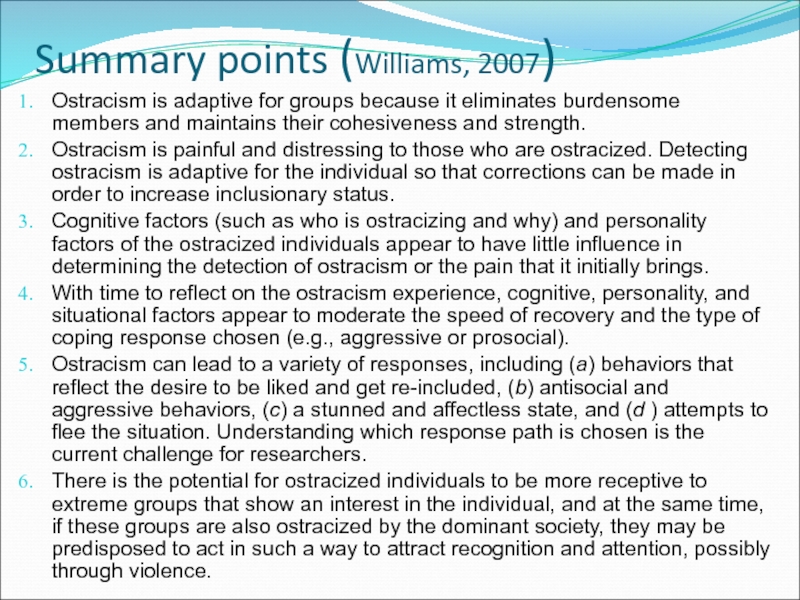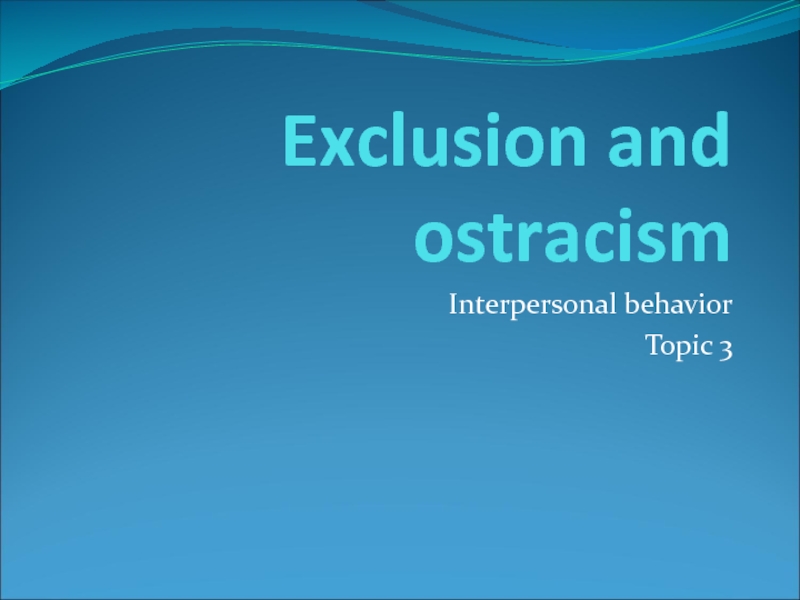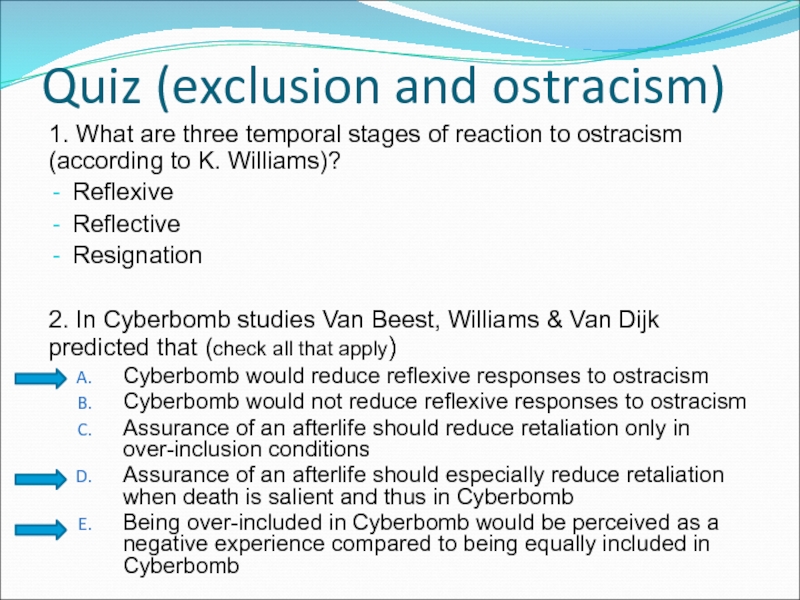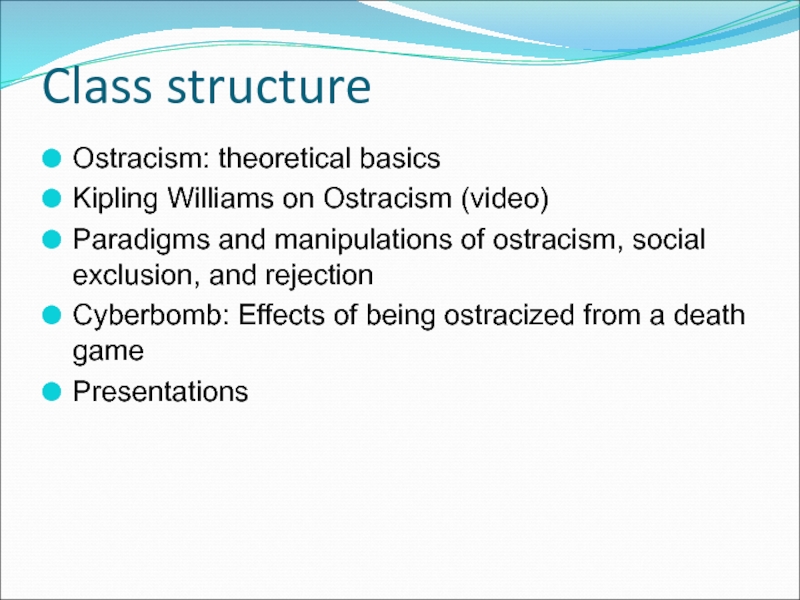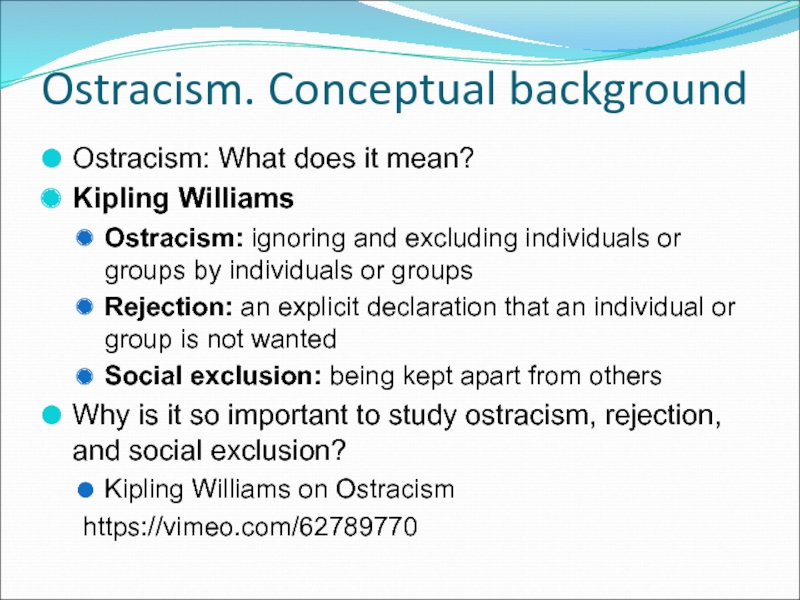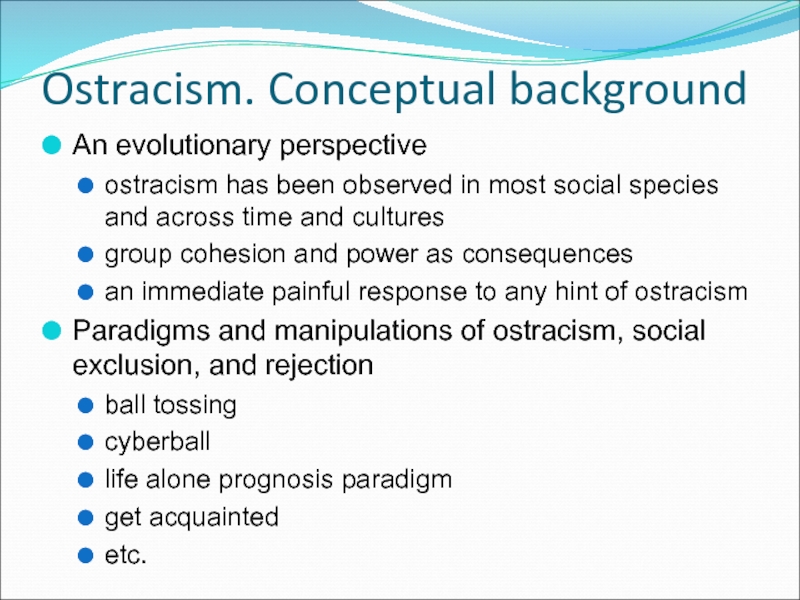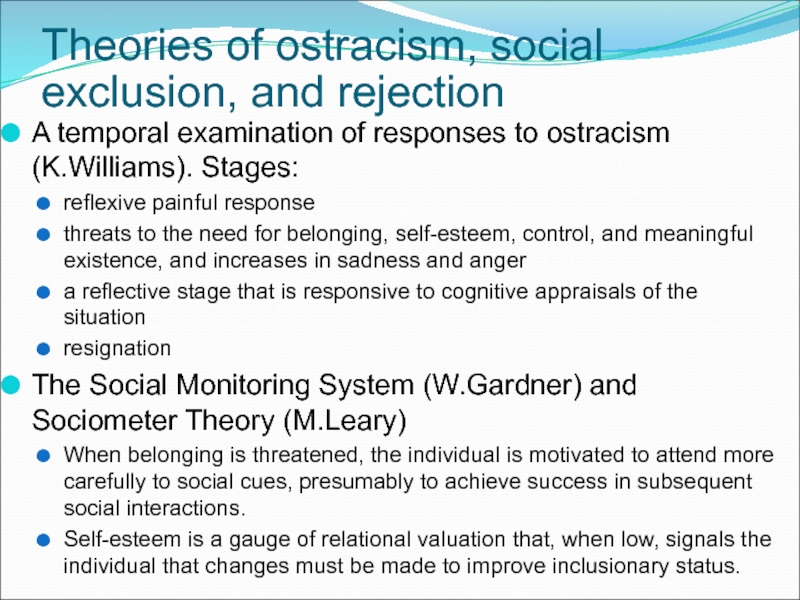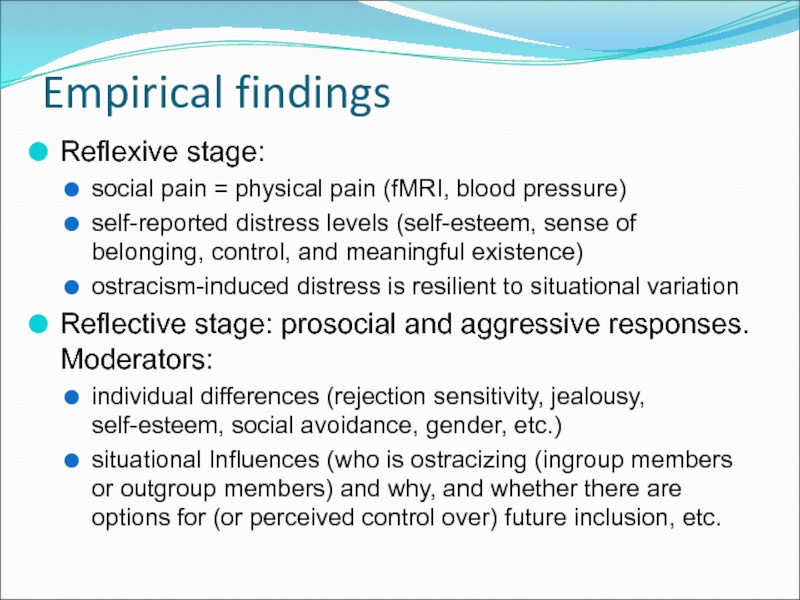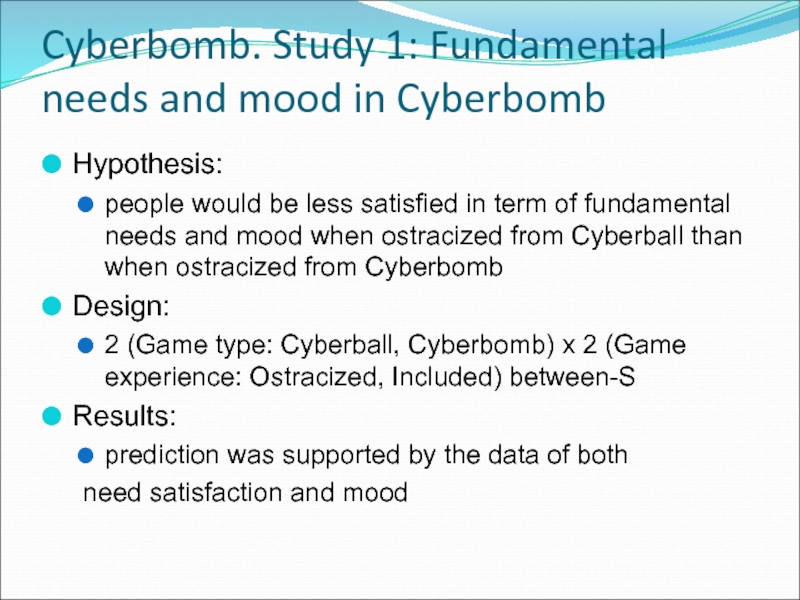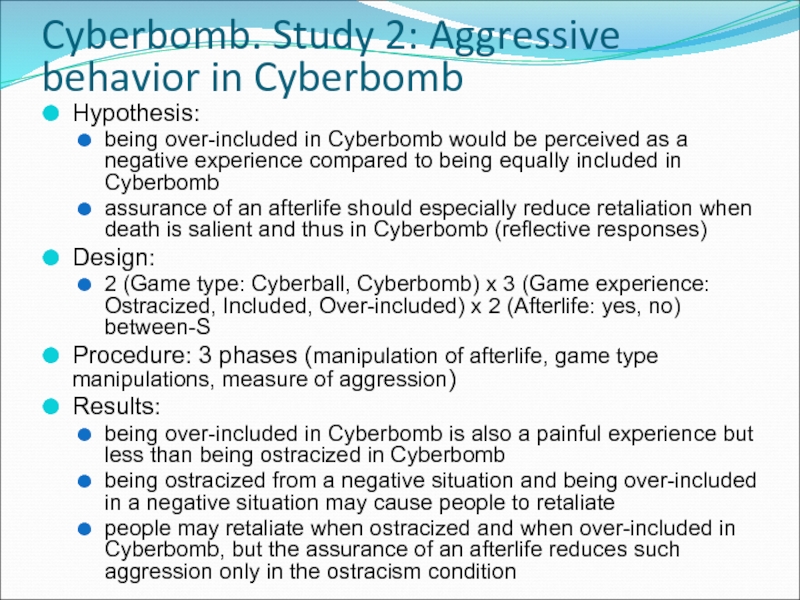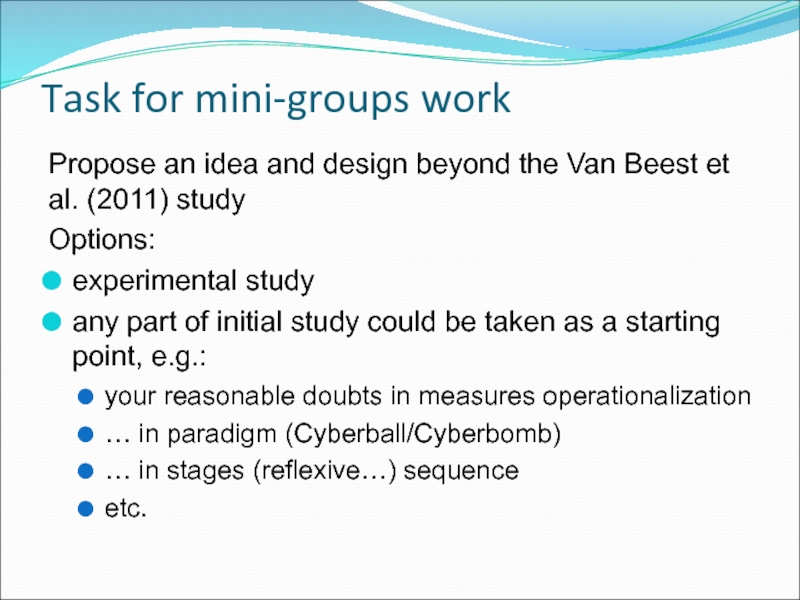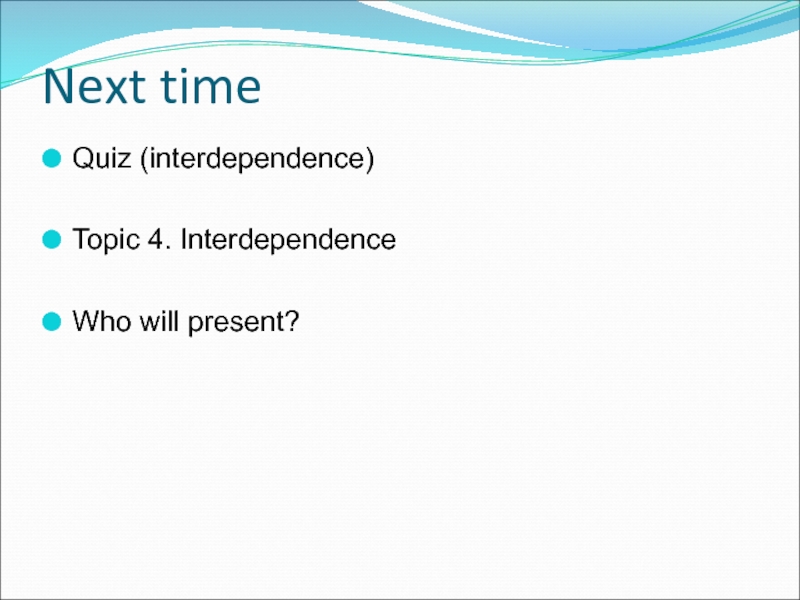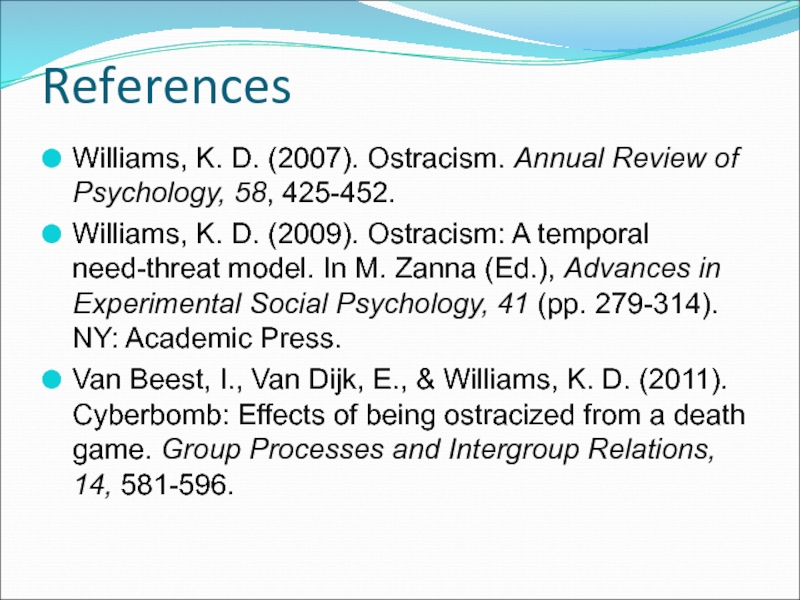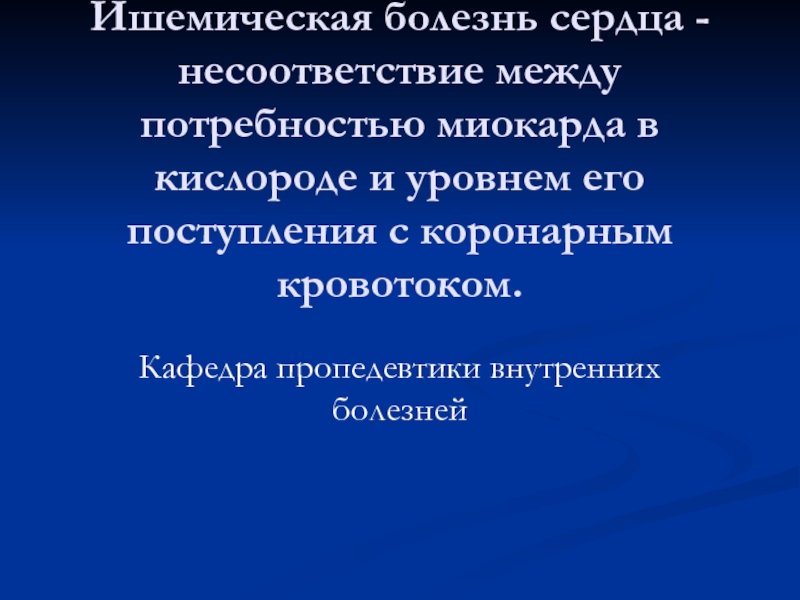Слайд 1Exclusion and ostracism
Interpersonal behavior
Topic 3
Слайд 2Quiz (exclusion and ostracism)
1. What are three temporal stages of
reaction to ostracism (according to K. Williams)?
Reflexive
Reflective
Resignation
2. In Cyberbomb studies
Van Beest, Williams & Van Dijk predicted that (check all that apply)
Cyberbomb would reduce reflexive responses to ostracism
Cyberbomb would not reduce reflexive responses to ostracism
Assurance of an afterlife should reduce retaliation only in over-inclusion conditions
Assurance of an afterlife should especially reduce retaliation when death is salient and thus in Cyberbomb
Being over-included in Cyberbomb would be perceived as a negative experience compared to being equally included in Cyberbomb
Слайд 3Class structure
Ostracism: theoretical basics
Kipling Williams on Ostracism (video)
Paradigms and manipulations
of ostracism, social exclusion, and rejection
Cyberbomb: Effects of being ostracized
from a death game
Presentations
Слайд 4Ostracism. Conceptual background
Ostracism: What does it mean?
Kipling Williams
Ostracism: ignoring and
excluding individuals or groups by individuals or groups
Rejection: an explicit
declaration that an individual or group is not wanted
Social exclusion: being kept apart from others
Why is it so important to study ostracism, rejection, and social exclusion?
Kipling Williams on Ostracism
https://vimeo.com/62789770
Слайд 5Ostracism. Conceptual background
An evolutionary perspective
ostracism has been observed in most
social species and across time and cultures
group cohesion and power
as consequences
an immediate painful response to any hint of ostracism
Paradigms and manipulations of ostracism, social exclusion, and rejection
ball tossing
cyberball
life alone prognosis paradigm
get acquainted
etc.
Слайд 6Theories of ostracism, social exclusion, and rejection
A temporal examination
of responses to ostracism (K.Williams). Stages:
reflexive painful response
threats to the
need for belonging, self-esteem, control, and meaningful existence, and increases in sadness and anger
a reflective stage that is responsive to cognitive appraisals of the situation
resignation
The Social Monitoring System (W.Gardner) and Sociometer Theory (M.Leary)
When belonging is threatened, the individual is motivated to attend more carefully to social cues, presumably to achieve success in subsequent social interactions.
Self-esteem is a gauge of relational valuation that, when low, signals the individual that changes must be made to improve inclusionary status.
Слайд 7Empirical findings
Reflexive stage:
social pain = physical pain (fMRI, blood pressure)
self-reported
distress levels (self-esteem, sense of belonging, control, and meaningful existence)
ostracism-induced
distress is resilient to situational variation
Reflective stage: prosocial and aggressive responses. Moderators:
individual differences (rejection sensitivity, jealousy, self-esteem, social avoidance, gender, etc.)
situational Influences (who is ostracizing (ingroup members or outgroup members) and why, and whether there are options for (or perceived control over) future inclusion, etc.
Слайд 8Cyberbomb. Study 1: Fundamental needs and mood in Cyberbomb
Hypothesis:
people would
be less satisfied in term of fundamental needs and mood
when ostracized from Cyberball than when ostracized from Cyberbomb
Design:
2 (Game type: Cyberball, Cyberbomb) x 2 (Game experience: Ostracized, Included) between-S
Results:
prediction was supported by the data of both
need satisfaction and mood
Слайд 9Cyberbomb. Study 2: Aggressive behavior in Cyberbomb
Hypothesis:
being over-included in Cyberbomb
would be perceived as a negative experience compared to being
equally included in Cyberbomb
assurance of an afterlife should especially reduce retaliation when death is salient and thus in Cyberbomb (reflective responses)
Design:
2 (Game type: Cyberball, Cyberbomb) x 3 (Game experience: Ostracized, Included, Over-included) x 2 (Afterlife: yes, no) between-S
Procedure: 3 phases (manipulation of afterlife, game type manipulations, measure of aggression)
Results:
being over-included in Cyberbomb is also a painful experience but less than being ostracized in Cyberbomb
being ostracized from a negative situation and being over-included in a negative situation may cause people to retaliate
people may retaliate when ostracized and when over-included in Cyberbomb, but the assurance of an afterlife reduces such aggression only in the ostracism condition
Слайд 10Task for mini-groups work
Propose an idea and design beyond the
Van Beest et al. (2011) study
Options:
experimental study
any part of initial
study could be taken as a starting point, e.g.:
your reasonable doubts in measures operationalization
… in paradigm (Cyberball/Cyberbomb)
… in stages (reflexive…) sequence
etc.
Слайд 11Next time
Quiz (interdependence)
Topic 4. Interdependence
Who will present?
Слайд 12References
Williams, K. D. (2007). Ostracism. Annual Review of Psychology, 58,
425-452.
Williams, K. D. (2009). Ostracism: A temporal need-threat model.
In M. Zanna (Ed.), Advances in Experimental Social Psychology, 41 (pp. 279-314). NY: Academic Press.
Van Beest, I., Van Dijk, E., & Williams, K. D. (2011). Cyberbomb: Effects of being ostracized from a death game. Group Processes and Intergroup Relations, 14, 581-596.
Слайд 13Summary points (Williams, 2007)
Ostracism is adaptive for groups because it
eliminates burdensome members and maintains their cohesiveness and strength.
Ostracism is
painful and distressing to those who are ostracized. Detecting ostracism is adaptive for the individual so that corrections can be made in order to increase inclusionary status.
Cognitive factors (such as who is ostracizing and why) and personality factors of the ostracized individuals appear to have little influence in determining the detection of ostracism or the pain that it initially brings.
With time to reflect on the ostracism experience, cognitive, personality, and situational factors appear to moderate the speed of recovery and the type of coping response chosen (e.g., aggressive or prosocial).
Ostracism can lead to a variety of responses, including (a) behaviors that reflect the desire to be liked and get re-included, (b) antisocial and aggressive behaviors, (c) a stunned and affectless state, and (d ) attempts to flee the situation. Understanding which response path is chosen is the current challenge for researchers.
There is the potential for ostracized individuals to be more receptive to extreme groups that show an interest in the individual, and at the same time, if these groups are also ostracized by the dominant society, they may be predisposed to act in such a way to attract recognition and attention, possibly through violence.
